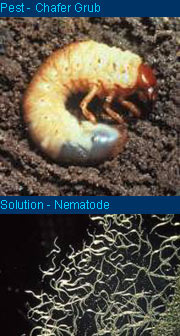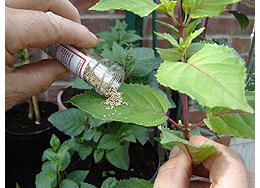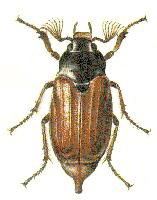Chafer Beetle Larvae - lawn pest
 Signs
- Patches of affected lawn wilt and turn yellow
or brown, though this is not specific to chafer beetle larvae
and can seem in the early stages like seasonal drought or stress.
On investigation, the grass can be lifted easily from the soil
not held down by roots to any degree. This can also happen with
otherwise apparently healthy grass if there are enough larvae
feeding actively enough. On lifting the turf and looking into
the top couple of inches of soil, the soft-bodied grubs themselves
are seen. Up to 2cm (3/4") long, "C" shaped, cream coloured
with a darker head and three pairs of legs.
Signs
- Patches of affected lawn wilt and turn yellow
or brown, though this is not specific to chafer beetle larvae
and can seem in the early stages like seasonal drought or stress.
On investigation, the grass can be lifted easily from the soil
not held down by roots to any degree. This can also happen with
otherwise apparently healthy grass if there are enough larvae
feeding actively enough. On lifting the turf and looking into
the top couple of inches of soil, the soft-bodied grubs themselves
are seen. Up to 2cm (3/4") long, "C" shaped, cream coloured
with a darker head and three pairs of legs.
Damage - Dead patches of lawn, may be made worse by animals such as birds, foxes or badgers ripping up the grass to get at the larvae, they may also attract moles getting at them from underneath. Damage usually occurs during the autumn and is more common on light sandy soils where grass growth is already poor. Rarely may affect other plants in the vicinity, but grass roots are the usual food source.
 Treatment - Best approached by
attacking the larvae themselves in conjunction with improving
the conditions that allowed them to become established in the
first place - i.e. looking after the lawn.
Treatment - Best approached by
attacking the larvae themselves in conjunction with improving
the conditions that allowed them to become established in the
first place - i.e. looking after the lawn.
There is an organic biological control for chafer grubs using a parasitic nematode called Heterorhabditis. The nematode searches for insect larvae and then enters through a natural body opening or sometimes through the skin. Once inside the nematodes produce bacteria, which kills the larva and feeds the nematode. The larva dies within a few days and the colour goes from white to brown. The nematode breed in the dead larva and search for new ones once they have killed their host.
Chemical treatments are also available, it's a not a cheap pest to deal with as they are often dispersed across the lawn and hidden beneath it, so there's a large area to deal with even in quite modest gardens. In any case it's cheaper to deal with the pest by chemical or biological means than it is to replace the lawn, even if you don't take the time and effort of doing so into consideration.
Q. I have recently moved to Thetford, and my lawn has been attacked by a white caterpillar looking bug which my neighbours say are "Chafer Beetle" larvae and that they eat the grass roots. Apparently, they like the light, sandy, Breckland soil. The only suggested remedy is to lift the grass in turves and remove the larvae from the soil and roots. I did this over an area of about 4 sq m and found hundreds of larvae. This, of course, effectively destroyed the affected area of grass.
A. As you have found, you have the larvae of Chafer beetles, usually either cockchafers or garden chafers, they feed on grass roots.
Damaged turf will lift away as the roots have been eaten and no longer hold the turf in the ground. Small mammals such as birds, badgers and foxes can cause further damage as they lift turf looking for the grubs to feed on. The grubs are soft bodied, cream in colour with tan or brown heads.
Control used to be with carbaryl though this is now no longer an option as this is now a restricted chemical - prescription only, used for killing head lice!
Fortunately there is a now a biological control available to eradicate these pests. This is pet, child and environmentally friendly in a way that any chemical solution cannot be.
Go for a co-coordinated approach and apply an spring or autumn lawn feed as well to help the grass recover. The beetles emerge in the late spring to early summer and this is when they lay their eggs for next years crop of larvae.
Don't expect a quick fix, particularly if they're endemic to the area. They may have built up in numbers for some reason over a period of time, you say you've just moved to the area - was the garden neglected? If you keep addressing the problem little and often (after the first onslaught!) then it should get under control.

Insect
hotel / house
A sheltered insect house to help a range of beneficial
insects to over-winter in your garden. If they are over-wintering there,
they are in an ideal position come the spring and summer to wake up and
help to combat any pests you may have. Amongst others, good for ladybirds,
lacewings and solitary wasps which will help keep your unwanted garden visitors
down. Place in a sheltered place outdoors.

Biological
Pest Control - Organic living pest control for a variety of
problems, red spider mite, whitefly, fungus gnats (sciarid fly), thrips, mealy bug,
vine weevils and more.
These are parasites or predators that will specifically infect the pest they are brought in to control without harming any other living things and without the use of chemicals. A small population of pests needs to be maintained so that the control agent doesn't die out.

Chemical insecticides - If your plants get a heavy infestation, then I think it's acceptable to use a chemical insecticide as a "smart missile" just on that particular plant. I resort to this when the aphids build up under cover on my favourite plum tree, or other plant/s. Don't overdo it and spray too often and don't spray the whole garden "just-in-case", buy a small 1L or thereabouts sprayer so you don't get carried away.
Not pest specific.
Reasons to like chafer beetles

- Adult chafers have a great pair of highly effective radar-like antennae that make them look a bit like science fiction space-ships.
- Adult chafers have the character of an eccentric old uncle. They fly into windows, or through open doors and windows into your house in a great rush causing panic and surprise and then having fallen on the floor and made a fool of themselves get back up onto their legs saying "Oops, oh dear me, where was I now? Sorry about that" - you have to listen really carefully to hear it though.
- Chafers belong to the Coleoptera, the beetles, and there are more beetle species than of any other animal group on the planet - by a long way, which is in itself impressive, if not terribly useful.
Copyright 2000 - present. All Rights Reserved | Privacy Policy Statement
